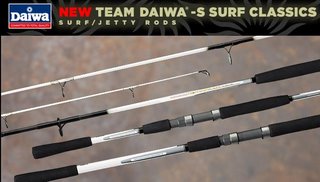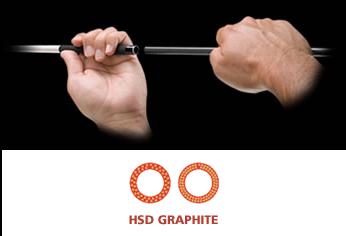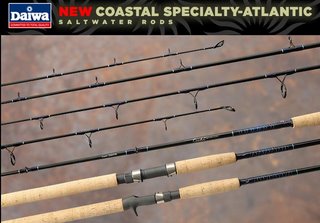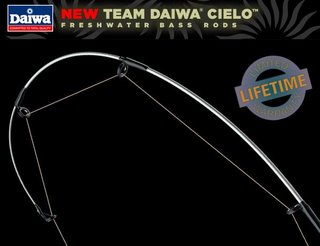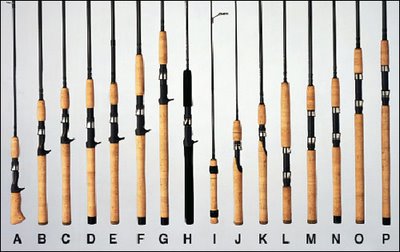Simply stated, Destroyer series rods are conceived and designed to redefine the conventional concept of bass rods, and they continue to evolve along this direction. In what follows we would like to explain the details of the concept and how it is executed in terms of manufacturing. We hope this will help not only the first time users but also the current Destroyer users to understand what Destroyer rods are all about.
1. Balance: 
Balancing a fishing rod in general is not a difficult thing to do. Yet, it seems most rod manufacturers do not bother doing it enough, to our surprise. Balancing is achieved mainly by installing a counterweight (see inset) at the butt end. Although the counterbalance is an additional weight, a balanced rod seems lighter than an unbalanced one. If you carry an 8-foot-long 2x4 piece of lumber in the middle, that is to mean ‘balanced’, instead of at the end, you have greater control over the piece, not to mention the fact that you can carry it with much more ease. This balance, coupled with the general lightness of the rod allows you greater control, and the feeling that the rod is a lot shorter and lighter than it actually is. This unique quality allows you to incorporate ‘wrist action’ in casting and other things you would like to do with your rod. And at the end of a long day you are much less tired. By the way, ‘balanced’ does not mean every Destroyer is balanced exactly at the same spot, namely their reel seats. The balance of each rod is tailored to its specific purpose. For instance, the ones for flipping and pitching are tuned to be forward-balanced for obvious reasons. Each Destroyer is uniquely balance-tuned, and this contributes to Destroyer’s legendary ‘weightless’ feel.
2. Lightness:When you pick up any of the Destroyer rod, the first thing that strikes you is its lightness. It feels almost ‘weightless’ if you hold it at the balancing point. As mentioned in the section of Balance, this will allow you to use your wrist more effectively for not only casting but also manipulating your baits as well. That is why you can give certain actions to your favorite baits only with a Destroyer. This is also what they mean when they say that the action of our baits is so much better when worked with Destroyer rods.
In order to achieve this lightness, we have to search for new materials of higher strength and different characteristics, and at the same time eliminate unnecessary ‘fat’ (weight/bulk) by designing better parts. Unlike many other so-called manufacturers who are actually assembly plants, Megabass is a manufacturer in origin. Founded in the city of Hamamatsu, which is also the birthplace of Honda, Suzuki and Yamaha to name only a few, Megabass works with other manufacturers such as Fuji and Daiwa in order to develop our own parts with our own design objectives. We do not simply choose from existing parts offered by other manufacturers. This will explain why Destroyers appear so original even by untrained eyes. This selective process at the same time eliminates sound deadening ‘fat’ from the rods and help increase the sensitivity of the Destroyer rods. And that may be why you get the ‘muscular’ impression from The Destroyer rods. Yet, you can pick it up with your index finger and thumb.
3. Sensitivity: 
Fishing is often a blind person’s game. The only communication with fish or their environment is through what you feel in your hand(s). What you feel in your hands is a vibration, which is a kind of sound but at much lower frequency than that of audible sound. The idea behind the Destroyer’s grip design is basically acoustic in this sense. We borrowed this idea from musical instruments. Musical instruments use some kind of cavity to amplify (try plucking a guitar string without its body (sound box), you will be surprised by the difference) or change the quality of the sound. If the instrument is not fitted well, it will produce unwanted sound called ‘noise’, which clouds the sound you want to hear. We eliminated noise through the precision manufacturing process, which we are very good at. Sound deadening is usually caused by glue and other fillers to fill or hide gaps created by a manufacturers’ inability to manufacture the parts exactly as specified by the designers. When an angler for the first time uses a Destroyer rod, he is usually overwhelmed by the sheer amount of ‘information’ he receives from his hands in terms of vibrations. Some anglers, who were used to holding the line in order to detect subtle bites, told us they no longer have to do that with Destroyers. The more information you receive, the more you will be involved with fishing. The sensitivity issue is most critical when you fish deep. With most of the line in the water you tend to receive less vibration. Most anglers remedy this problem by using lighter non-stretch lines. If combined with the Destroyer’s acoustic grip design, you have a winning combination. If you are a drop shot angler, F2-64xs for lighter application and F3-610xs for heavier application and versatility are a proven combination and highly recommended. For the year 2004 all Destroyer spinning rods received the Stealth Fit Housing reel seat (see inset), which was designed by I.T.O. Engineering (I.T.O. is a design arm of Megabass). This reel seat sits directly on the extended blank and transfers vibration directly to your hand. Now you know how serious we are about sensitivity.
4. Action, Taper and Blank Design: 
This is the key to understanding the Destroyer rods. The simplest blank taper design is a regular taper blank made of a single kind of graphite film with a regular taper mandrel. This traditional blank design has limited capabilities, and does not take advantage of the technology now available. Destroyer rods expand on this traditional design, and with the help of new technologies have come to design unique tapers that greatly increase the capabilities of each rod. When you want two opposing characteristics from a single blank, you have to venture into the world of technology and design innovation. What make the Destroyer series distinctly different from any other is the amazing range of the action and the feel of our blanks. How do we do this?
First, we develop and use different blank materials according to the purpose of each rod, instead of using the highest density carbon blindly as if the higher the better.
Second, we cut the graphite film in the way to produce a desired action, which is sometimes very different from the result of regular cut.
Third, many of our rods have non-traditional tapers. This is mainly why our rods possess sensitive tip sections and strong butt sections. As a result even with one of the lowest F-number (Force grade) rods, you are always in control of fish, not the other way around. One serious problem with conventional regular taper rods is that if you want to be able to cast lightweight bait, you are stuck with ‘wimpy’ rods, which will not give you any control over the bait or fish. On the other hand, the other extreme end would be the flipping stick. As the name implies, they have the feel of a ‘stick’ rather than a fishing rod. Why? Because all those flippers thought that is what they wanted. Any old stick will do provided it was long enough to cover the area and pull the fish out of the weed. But, the one problem was the ‘stick’ does not have any action in the tip section, therefore, you often take the bait out of fish’ mouth unintentionally when you set the hook. How many fish have you lost this way? The unique taper of our rods allows for a sensitive tip without sacrificing strength (among other things).
Fourth, blank materials. Take Tomahawk series glass rods, for example. The instant you pick up one of our Tomahawk rods, you will not believe it is a glass rod. It is so light. The reason is very simple. Our glass film is completely different from the ones used for other glass rods. The difference lies in the material. We are so into the world of rod action, we realized from the beginning that the only way to create more unique rod action is to examine the traditional blank materials and find out ways to improve at the material level. Our Destroyer Evoluzion series and the Hedgehog (Stinger tip) series are a case in point. Using unconventional materials such as Titanium and rare metals in the blanks (see inset), the feel of their action has been transformed to another dimension. If you like driving, you know how hard it is explaining the ‘driving feel’ of cars. It is the total feeling based on many factors including steering response, balance, stability, cornering, integrity, power, and so on. Destroyer rods provide qualitati
vely different responsiveness, sharpness and recovery from other rods because instead of using only one kind of blank material and one kind of mandrel (regular taper), we integrate other materials and the mandrel with different regularities. As a result our lineup offers a wide range of ‘feels’ in terms of rod action. And that is why often the only way to explain it to some one who has not been introduced to the Destroyer rods is to compare the sensation with the difference in driving feels between different makes of cars.
When you look at our Destroyer lineup, you will notice we offer shorter and longer rods with different taper designs for each force (F-number) category. That can be explained in a crude sense in comparison with baseball bats. Just like fishing rods, baseball bats vary in terms of their size and weight. Ichiro, who is a hit producer rather than a home run batter, uses a shorter and lighter bat in order to control the ball’s direction and angle. To him accuracy is more important than power. For this reason he rarely makes a full swing, While a home run batter like Barry Bonds would use a heavier and longer bat for obvious reason and swings full. We offer shorter rods so that anglers can enjoy controlling their own casting in terms of casting accuracy. But we do not stop there. We choose to use high modulus graphite carbon for our regular Destroyer rods, because it is the best graphite to produce the highest tensioned rod blanks. We further improved its tensile power by braiding them. The difference is that of wooden bat and the metal bat, perhaps. Our braided graphite blanks give back all they receive without absorbing any of the impact, just like a metal bat. That is what ‘high-tensioned’ means. This allows us to build our rods shorter than the conventionally built rods for the same power (castability). Our rods will have, for the same length, more power than the others. There is another gain. When fish strike, a higher tensioned rod recovers faster and with more force; therefore it produces a more secure hookset. That is why many Destroyer users claim it feels almost ‘automatic’. You do not even need to set the hook if you are throwing fast moving baits. Then, what about slow moving baits or when fish do not aggressively strike? Based on the high-tensioned rod concept, we have designed our Destroyers with various tapers, let alone rod lengths, to offer the widest variation in terms of blank action feel. Regular tapered rods tend to be good at casting, especially fast moving baits. But the ones with faster taper are more specialized and address the issue of a non-aggressive bite.
By the way, if you would like to test the integrity of Destroyer blanks, please try this. Place the mid section of your Destroyer on the palm of your left hand, and then hold the rod tip with your right hand and bring it to your eyes as if you are to look through the guides like a telescope. Now turn the rod using only the index finger and the thumb of your right hand. Notice the whole rod responds to the turn instantly. Destroyer rods have an enormous torque potential, which contribute to the high overall integrity of the rods.
5. Ergonomic design 
As mentioned earlier in the section about sensitivity, anglers receive all information through their hand, which holds the rod handle. If more surface area of your hand is on the grip, you will be able to feel the vibration more clearly because more sensors in your hand are put to use. Of course, comfort is important, but here I am only concerned with the kind of comfort a racing seat would provide, and not that of a big living room couch you sink your body into after a tiring day. That is the concept of our Man-tackle Interface (see inset). Its objective is a combination of achieving higher sensitivity and comfort. Ergonomic designing is a very difficult process because it is a highly subjective process. Yet, if you hit the right spot, almost every one will agree. Anything we touch, hold and use requires attention to this aspect of designing. A well-designed chair is very comfortable and often built well. Sometimes it takes a while to appreciate its true value, but once you become aware of its importance, you can no longer live without it. Well-designed tools express the simplest solutions to the problems often caused by contradictory design requirements. But unfortunately the simpler solutions are hard to come by, and often require painstaking processes of trial and error, and are therefore expensive. If you think your skill and muscles will compensate for the deficits of your tackle, think again. Without developing the skills and other resources to compensate the deficits of the tackle, you will not be able to perform and enjoy fishing (provided that it is actually possible for you to develop sensitivity and all other functions to match Destroyers in the first place). But, my hunch is you are more likely to quit the activity itself out of frustration. The funny thing is that the most skilled anglers (or carpenters, plumbers, electricians, and so on for that matter) always choose the best tools available. Why? Because only then can they maximize their skill and potential, as their tools help instead of hamper them in their work. That is one reason why they can get more out of fishing than others. Here, I am not talking about the number of fish you catch, but about the quality of your fishing experience. We believe that fishing tools are to help elevate and maximize your fishing experiences by allowing you to engage more deeply in the activity you love so much. Another way of saying the same thing may be that our tools will help minimize distraction so that you will be more focused and involved with fishing. For this reason we have developed new grips and guides with Fuji, and the new reel series with Daiwa. Out of the Man-tackle Interface concept, many patented part designs and construction methods have been invented. That is the job of I.T.O. Engineering, the design arm of Megabass. Let me describe some of these original designs and what they do for you.
The Arms Reel Seat (PAT.), developed with Fuji, is the most significant design breakthrough in terms of sensitivity and ergonomic comfort. This is the activity center of the entire Destroyer rod. Based on the original wood grip custom hand-carved by Yuki Ito some 20 years ago, The Arms Reel Seat is the result of the evolution. Every other part of the Destroyer is designed to be connected to the reel seat without any signal loss.

The Tapered Shaft Direct Through Structure has revolutionized conventional rod construction by extending the butt end of the blanks all the way through grips and reel seats to the very end of the rear grips. And not only that, the butt end of the blanks is tapered down so that when you cast with both hands, one hand is on where the reel is, (that is the thickest section of the blank), and the other is on the rear grip (see inset). The tapered butt end provides additional power and a sharper casting feel. And, since the blank itself does not provide enough strength, underneath the handle grip section, aluminum coated graphite pipe frame is inserted between the blank and the grip housing. The result is almost like an asymmetric bow. A traditional bow is a simple tool and the simplicity comes from the fact that the all of its power comes from each bow’s tensional potential, which is determined by its material and the construction. Fortunately, you do not need as much drawing power to use our Destroyers, but it may be useful to know the analogy. All of the Destroyer bait-casting models are constructed with this structure.
The Stealth Fit Housing (Spinning Reel Mount) (PAT.)
This reel mount is designed to sit directly on the blank, and fit perfectly in order to transmit every signal from the blank. Each mount is made out of a solid aluminum block.
The Coke Bottle Handle
For the same reason a Coke bottle is easy to grab, our narrower grip-end fits in your palm better, especially since your hand on the rear grip has to go through a much smaller circular movement.
The Level Spacer (PAT.)
On the underside of our bait-casters’ reel seat, a small section of the aluminum-plated graphite pipe frame is exposed. You can place your fingers directly on it to feel the sound transmitted through the blank, or place this aluminum Level Spacer (PAT.) to improve comfort and feel without losing sensitivity.
The Cask End-Grip (PAT.)
When you work your bait with a double-gripped rod, sometimes its end-grip interferes with your elbow. Our end-grip design not only reduces this annoying interference, but also let you take advantage of it. Let the Cask end-grip hit your elbow and use it to add additional lure action.
6. Fit and FinishThis topic always reminds me of what might be called the ‘penny test’. When Toyota Lexus first came out, they used a penny to check the fit and finish of each Lexus. The idea was that if everything was manufactured exactly, the space between the exterior (sheet metal) parts should be exactly the same everywhere on the car. They would test this by slipping a penny along the gaps (eg. Doorframe, etc.). This attention to detail is not lost on the Destroyer series. You can do a similar test to your Destroyers. First, find a level surface, then, let your Destroyer stand on its grip end. It is harder with a spinning rod, but I am usually able to succeed. Another test we suggest you do is turning the fore-grip. It is smooth and precise, and fit so exactly that there is no rattle or irregularity. In order to achieve this level of fit and finish quality, you can imagine how much trouble Megabass must have gone through. Bringing up the ‘perfection’ rate from say, 90% to 100% takes a lot more resources than to raise it from 80% to 90%. It is same 10%, but the difference is exponential in terms of the effort, money and ingenuity required. That is why there are only a few manufacturers who even attempt to reach this highest goal. If you are not able to see and appreciate this, Lexus’ fit and finish will be wasted on you. This applies to the Destroyers as well.
7. Exterior Design 
When your eyes fall for the first time on a Destroyer rod, one of the things you will see right away is the quality (both material and design) of each component. In fact there is so much detail within each component that you might like to use a magnifying glass to see them all. As each component has definite reason to be exactly what and where it is, the rod as a whole conveys a functional beauty without frivolous ornament. It is austere and serious, yet not overbearing. Here again we enter into the previously mentioned elusive world of the beauty. Objects attempt to communicate with you visually or not. And after a while an impression is formed in your mind. This is private. That is why sometimes it is very hard to describe it to others, and for that reason those attempts often fail miserably. Yet, one thing is clear. We all enjoy beautiful objects. That is why we do not disregard the aesthetic value of ‘even’ a fishing rod. We intentionally expose a section of the mesh graphite blank because we think it is so pretty. Bare materials tend to have this distinctive beauty within them, and sometimes all you have to do is to recognize it and not to conceal it senselessly. This should explain why many Destroyer users display their rods and enjoy them as objects as well as fishing tools. Please take time to look closely at each component. You will discover many little unconventional ‘tweaks’, and wonder what functions they perform. In case you cannot figure out, please let us explain for you.
8. PowerWhen you start to pull the line which is dangling from the top guide, you notice that the rod blank starts to bend from the rod tip. The reason the bending curve of the fishing rod is so attractive is that the curve changes proportionately to the load. The bending point begins to shift very fast, and then it disappears when it hits the maximum power point (in another word, the breaking point). When the blank ‘gives’ by responding to the load, it bends. The section of the blank which does not ‘give’ much is the butt section. This is where the buck stops. Our Force scale (F number) is based on the maximum load the butt section can withstand, nothing to do with the taper of the blank. As you know, the slower the taper the stiffer it is. F number is often used to mean power rating of a given rod, just like the maximum horse power of an engine. One of the basic design concepts underneath the Destroyer rods is to pack more power (horse power and torque as well) without making the rods heavy. That is one of the reasons we use Titanium for our Evoluzion Series rods. If 2-liter engine can produce 200 hp, why do we need bigger engines with less power? The bigger engines make the cars heavier, which demands more power to compensate the extra weight, which affects the handling of the car. It does not make sense unless there are other design objectives to be considered. But, the only way to increase horse power is to design engines which can run at very fast rpm. Destroyer rods are in this sense very much like cars: smaller, therefore lighter engines with more power. Perhaps the titanium wires of the Evoluzion rods work like turbo chargers to boost power. But, the role of horse power in terms of ‘driving pleasure’, which is a much larger and complex concept, is rather small. Just like a well balanced car will give you better handling (and therefore more ‘driving pleasure’) a well balanced rod will increase your ‘fishing pleasure’. Power and other elements involved with the designing of fishing rods should be at the same time judged by this overall concept ‘fishing pleasure’.
9. Tackle IntegrationOnce you understand that more capable baits demand more capable rods, you begin to realize the need for tackle integration. And I am not just talking about ‘matching’ them together. As I have mentioned, each rod has its maximum load capacity, but it does not mean it is a rigid thing. It is influenced by a number of other factors such as stretchiness of the line you use, drag setting, amount of excess line when you set hook, and weight of the line itself. But, there is one more thing which is critical to the concept of Tackle Integration. That is your body and mind. Next time you cast or set hook, please pay attention to you body. You will immediately notice what each part of your body contributes to your casting or hook setting action. Just like fishing rods are all about ‘give’ (and ‘recovery’), your hands, wrists, elbows, shoulders, waist, knees and finally feet are designed to ‘give’. In this sense fishing is about controlling the ‘give’. The angler and his tackle are sort of sandwiched between the fish and the boat deck, neither of them ‘gives’ very much. The reason a fishing rod breaks is usually due to overload caused by any one of the following: the line, reel drag setting, hookset angle and finally, your rigid body. If a fishing rod is an extension of your arm, then the reverse is also true; your body is an extension of fishing tackle. For this reason, the Destroyer rods usually start to change your body and mind so that you become the extension of the Destroyer rods. There are many doors to the world of Megabass. You may enter through one of our baits, feeling frustrated with the limitations of the rods you have to use for them. Or, you have been in search of better rods and encountered the Destroyer somehow. Your first Destroyer in your hands tells you that Megabass is serious about designing and building the very best fishing rods. When you start to use the rod on the water, your body and mind begin adjusting to their overall handling superiority, thanks to its lightness, balance and sensitivity. Your body will respond to the change. First, you might start to feel uncomfortable wearing thickly padded and overly protective shoes. After all, everything from the fish you have just set hook and your own body weight has to be balanced and controlled by your two feet. The sensitivity of your Destroyer demands you to become more sensitive to your environment, and asks you to shed the protective gear you have been wearing. I know an angler who switched to wrestling shoes. If you can cast more accurately and efficiently with greater ease, naturally you will be more involved with fishing, and enjoy your activity. Then, you will be more content with the world you live in and yourself. The Destroyer rods are like your bare arm. There is nothing unnecessary attached to them. It is definitely lean but muscular enough. Tools should never become an obstacle for you to experience whatever you are doing. Do you know why the Japanese are perfectionists and so good at making things? Here is my theory. They have discovered long time ago that the process of making things induces a certain kind of mental state. It is like a meditative state but at the same time you can get pure excitement as well. I believe this has something to do with Zen Buddhism. The key is not the finished products, but the tools use. If your mental state is pure, free of distractions, it shows in your result. And the first cause of distraction to be eliminated is the one caused by the tools you use. Those perfect or near perfect tools will allow you to experience your activity you are engaged in directly. That is why you can finally have a pure relationship with your activity. When we are completely involved with some activity, we notice (only later though), that it was as if time did not exist (we are often surprised at how long we have been fishing, for example). Otherwise we are always tied to time and therefore death. When we are free from time we are free from death, and we can touch eternity, which is the source of pure excitement. It seems life begins only when time stops, and in this sense good tools can stop or at least slow time for you. The Japanese seem happiest when they are using hand tools. They know only the best tools allow them to be completely engaged in the activities which produce the best products. In another word, if you want to have the best fishing experience, you must desire for the best fishing tools. What other hand tools do you use all day? We hear often fishing is a great outdoor activity. That is true. But, we believe fishing is at least equally significant in the sense that this may be the last hand tool many of us do not mind using all day. And as far as the world of tools goes, we can only improve them. From the very beginning Megabass has been driven by this desire for perfection shared by many users in Japan, which by the way explains why our products have been enormously popular over there.
You thought you were the master who chooses and controls your tools. Well, the truth is that is just the half of the relationship between us and the tools we use. If you listen to what Destroyer rods tell you and respond to them, only then will you start to become one with the Destroyer, and Tackle Integration will begin.

















